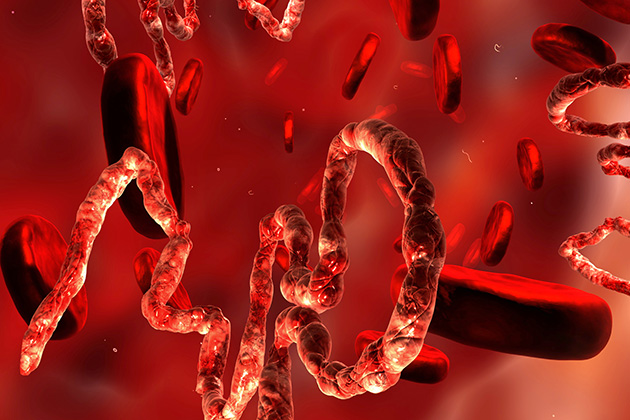
Of the nine Ebola virus disease patients known to have been treated in the United States, seven are now free of the disease.
By almost any measure, that’s an impressive success rate for a disease that the World Health Organization says has a mortality rate of nearly 70 percent.
Although the number of patients is small, it’s likely that part of the improvement in survival in the U.S. is due to the health care infrastructure that is able to provide basics such as fluid replacement and other supportive care. It is also possible that experimental treatments and plasma (blood) transfusions from Ebola survivors have been effective.
Could it mean that science is close to getting the upper hand?
“I, for one, am optimistic we’ll have a vaccine for Ebola virus disease sooner rather than later,” says Dr. Paul Skolnik, an infectious diseases physician who chairs the Department of Medicine and co-directs the Ebola Task Force at UConn Health. “The fact that plasma from patients who have recovered from certain viral diseases, like hepatitis B, varicella (chickenpox), and rabies, can help to treat these illnesses gives optimism that a vaccine can be made to help prevent Ebola. We’re very good at making these types of vaccines.”
The evidence suggests that antibodies may be helpful to treat the infection, as well as prevent it. — Dr. Paul Skolnik
Several patients, including Nina Pham, one of the nurses who contracted Ebola after caring for Ebola patient Eric Duncan in Dallas, Texas, were treated in this manner and were cured. Doctors at a National Institutes of Health facility in Maryland treated Pham with plasma donated from an Ebola survivor. She was discharged last week.

“The use of an immunoglobulin, or antibody, preparation to treat infectious disease is a time-honored and well-known therapy,” Skolnik says. “The plasma, or blood, from a patient who’s recovered from Ebola virus disease is useful because it contains antibodies to fight the virus. Simply put, these antibodies bind to the virus so it can be gobbled up by other cells. There may be other factors in plasma that are important. Based on first principles, this is why we believe it may be possible to develop a preventive vaccine for Ebola. The evidence suggests that antibodies may be helpful to treat the infection, as well as prevent it.”
It’s a similar concept to what makes other vaccines effective. Inactivated or molecularly produced parts of an infectious pathogen are introduced to the immune system, which triggers the body to recognize the parent virus and marshal a response to prevent it by creating antibodies against the infection. This is referred to as “active immunity,” because the body must create the antibodies for the defense.
“It’s often harder to develop vaccines for viruses that are kept in check mostly by the cellular arm of the immune system (infection fighting cells), Skolnik says. “This is the case, for instance, with HIV infection.”
Transfusion of Ebola-survivor plasma is an example of “passive immunotherapy,” he says. The donor blood already has the antibodies, because the donor’s immune system already had created them.
Put another way, while a vaccine introduces the plans to build an army to fight a specific enemy, the transfusion supplies the army, already trained and ready to fight.
“The advantage of an Ebola vaccine, once we have one, is it can be mass produced and therefore mass distributed to prevent disease from occurring,” Skolnik says. “Plasma therapy is used once patients are already sick and requires donor and host to have compatible blood types – there aren’t a whole lot of Ebola survivors in the world to serve as donors. A vaccine would be preferable, more cost-effective, and much easier to use across broad populations as a preventative measure, rather than a therapy.”
Clinical trials for two experimental Ebola vaccines are underway in the U.S. and overseas, and a third therapy, a two-vaccine regimen, is expected to start testing in January.



